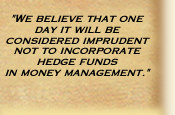June 6, 2011 – New York, NY – Rarely do equity market pundits focus on real performance returns (nominal returns less core inflation). Reporting nominal returns, rather than real returns, is the standard of measurement for the media. However, it can be misleading to the average investor who may assume that a +12% nominal return is better than a +9% nominal return since they do not consider the "core inflation rate". A +12% nominal return with +7% core inflation is actually worse than a +9% nominal return with +2% core inflation. The real return of the first period is +5%, while the real return for the second period is +7%. While the concept of nominal versus real returns is common knowledge for professionals, it is not for most investors. Furthermore, it is not a standard of measurement routinely discussed when pundits analyze market returns in the media.
Hennessee Group LLC, an adviser to hedge fund investors, analyzed the historical relationship between inflation and equity prices dating back to the 1970’s. According to Hennessee Group’s research, the equity market, represented by the S&P 500 TR, has generated a return of over +700 basis points above inflation on an annualized basis since the 1970’s.
| |
Annualized Data |
| |
Inflation |
S&P 500 TR |
Difference |
| 1970's |
7.36% |
5.88% |
-1.48% |
| 1980's |
5.08% |
17.56% |
12.48% |
| 1990's |
2.92% |
18.21% |
15.29% |
| 2000's |
2.53% |
-0.95% |
-3.48% |
| All Time Periods |
2.74% |
9.87% |
7.13% |
| Source: Standard and Poors and Federal Reserve Bank of St. Louis. Note, the Fed did not provide returns for S&P 500 TR (dividend reinvested). |
In 2009 and 2010, real returns were +23.8% and +13.6%, respectively, and +18.5% annualized. However, despite the great performance of equity markets since the credit crisis ended, the markets still generated a negative real return of -3.48% from 2000 to 2009, the worst decade in the last 40 years. This was 200 basis points worse than the 1970’s decade, which is remembered for periods of hyper inflation and a -40% correction from 1973 to 1974.
Investors should be encouraged by the above average real return the equity markets have provided during the past two years. Equity markets have stabilized, generating double digit returns for investors in two consecutive years while inflation has averaged only +2%. Through May, the S&P 500 is up over +7% this year relative to a core inflation reading of below +2%, generating a real return in line with historical averages.
| |
Annualized Data |
| |
Inflation |
S&P 500 TR |
Difference |
2006 |
2.50% |
15.79% |
13.29% |
2007 |
4.10% |
5.50% |
1.40% |
2008 |
0.10% |
-37.00% |
-37.10% |
2009 |
2.70% |
26.45% |
23.75% |
2010 |
1.50% |
15.06% |
13.56% |
| Source: Standard and Poors and Federal Reserve Bank of St. Louis. Note, the Fed did not provide returns for S&P 500 TR (dividend reinvested). |
The Hennessee Group believes this recent performance is part of a long term reversion to the mean in the spread between inflation and the equity markets and expects further improvement in 2011. With reasonable year-over-year earnings growth for S&P 500 of +17%, an improving global economy, an accommodative Fed, and muted inflationary pressures at the core level, the Hennessee Group believes the outlook for real returns above +7% remains favorable through the election in 2012. Beyond that point, pundits are polarized with some predicting inflation and others deflation depending on job creation, velocity of money and housing (to name a few).
CONCLUSION
In the Hennessee Group’s opinion, the investment community should discuss real returns, which are hardly, if ever, a topic of coverage in the media. A chart showing the direction of real returns, albeit sometimes frustrating in light of headline inflation (especially related to commodities), would offer the investor another dimension to their understanding of the real value added or lost in the equity markets. The media and pundits should discuss and debate both nominal performance and the real return above inflation. Lower inflation coupled with lower performance does not necessarily translate to lower purchasing power. This research paper is intended to shed light in a corner often ignored and encourage a more in depth and consistent discussion of real returns over nominal returns by the media and market pundits. The Hennessee Group purposely avoided incorporating QE2, headline inflation, taxes and pension liabilities in order to make a general point about real returns without inordinate complexity.
For PDF copy, click here.
About the Hennessee Group LLC
Hennessee Group LLC is a Registered Investment Adviser that consults direct investors in hedge funds on asset allocation, manager selection, and ongoing monitoring of hedge fund managers. Hennessee Group LLC is not a tracker of hedge funds. The Hennessee Hedge Fund Indices® are for the sole purpose of benchmarking individual hedge fund manager performance. The Hennessee Group does not sell a hedge fund-of-funds product nor does it market individual hedge fund managers. For additional Hennessee Group Press Releases, please visit the Hennessee Group’s website. The Hennessee Group also publishes the Hennessee Hedge Fund Review monthly, which provides a comprehensive hedge fund performance review, statistics, and market analysis; all of which is value added to hedge fund managers and investors alike.












